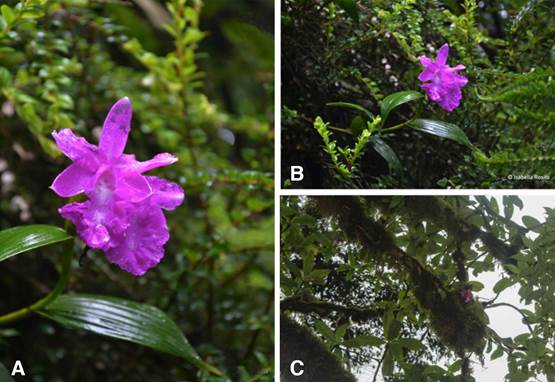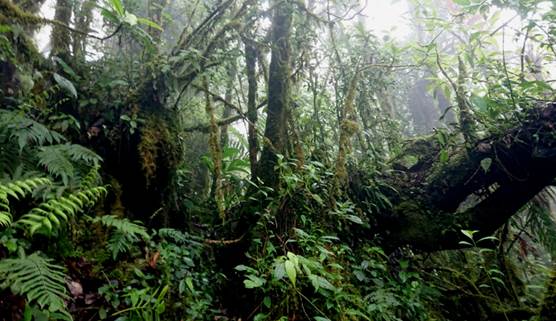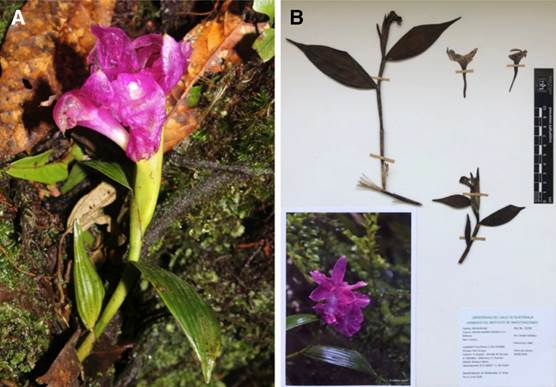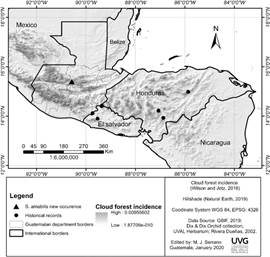Introduction
The genus Sobralia Ruiz & Pav. includes about 200 species native to the Neotropics (Baranow, Dudek & Szlachetko 2017, Dressler, Acuña Zamora & Pupulin 2016). These are known for their bamboo-like stem, with showy and ephemeral flowers that have taxonomic importance for discriminating sections and species (Brieger 1983). Dressler (2009) recognized the difficulty to classify sobralias by enumerating a few species complexes. The whole genus is noted for its lack of clarity in taxonomy and distribution, due mainly to intraspecific variation, and the difficulty of observing flowering plants in the field, because they are short-lived and have floral synchrony. Additionally, taxonomically informative herbarium specimens are hard to obtain, since the flowers deteriorate during the collection procedures (Baranow & Szlachetko 2016, Dressler & Bogarín 2007). In Guatemala, about 14 Sobralia species have been generally accepted (CONAP 2019, Dix & Dix 2000, WCSP 2019). Among these species, Sobralia amabilis (Rchb.f.) L.O.Williams has been classified under four synonyms in two genera since its discovery and description in 1852 (Reichenbach 1852, Reichenbach 1866, Schlechter 1923, WCSP 2019, Williams 1946, Williams 1956). Even in recent years, the need to improve the diagnostic characteristics among closely related species, S. amabilis (Rchb.f.) L.O.Williams, S. lepida Rchb.f. and S. wercklei (Schltr.) L.O.Williams has been brought up (Dressler 2003), and the lack of unified criteria in conspecific areas is obvious (Bogarín et al. 2014).
These species were first reported in northern Central America within a 44-year gap; Sobralia wercklei was first recorded in Honduras (Williams 1956), then as S. lepida in El Salvador (Hamer 1981), as S. amabilis and S. wercklei in El Salvador (Siegerist 1984), and S. amabilis in Guatemala (Dix & Dix 2000). The Guatemalan specimen was registered near the summit of Volcán Chingo, above coffee plantations in broad- leaf oak forest, close to the border with El Salvador. We know of no other citation for a locality in Guatemala. However, during an Ecological Assessment course field trip from Universidad del Valle de Guatemala, in June 2018, we collected S. amabilis (Fig. 1) on a private farm in western Alta Verapaz, Guatemala. This specimen represents a new location for the distribution of S. amabilis. Below, we detail its taxonomic history, description in vivo and specimen photographs, habitat notes, and recommendations for collecting Sobralia specimens.
Taxonomic history
Heinrich G. Reichenbach first described this orchid as Fregea amabilis Rchb.f. (1852: 712-713), from a specimen collected in Cordillera de Chiriquí, Panama, by Józef Warszewicz. Fourteen years later, Reichenbach described a similar orchid from Paso del Desengaño in Costa Rica and named it Sobralia lepida Rchb.f. (1866: 68). Later, Rudolf Schlechter described a new species, F. wercklei Schltr. (1923: 9), collected in San Jerónimo, Costa Rica, and distinguished it from F. amabilis for its greater height, broader leaves, and larger labellum. Then, Louis O. Williams (1946), while working on the Orchidaceae section of the Flora of Panama, determined that there are no differences between the genus Fregea Rchb.f. and Sobralia, so he included Fregea as a synonym of Sobralia, and he transferred F. amabilis to S. amabilis. Williams (1956), during the enumeration of the orchids of Central America, included S. amabilis, S. lepida and synonymized F. wercklei to S. wercklei, each one as a separate species. Right now, S. amabilis, S. lepida, and S. wercklei are not included in any of the Sections accepted for Sobralia (Dressler 2002).
Taxonomic treatment
Sobralia amabilis (Rchb.f.) L.O.Williams, Ann. Missouri Bot. Gard. 33: 30. 1946.
Synonyms (WCSP 2019):
Sobralia lepida Rchb.f., Beitr. Orchid. -K. C. Amer.: 68 (1866).
Fregea wercklei Schltr., Repert. Spec. Nov. Regni Veg. Beih. 19: 9 (1923).
Sobralia wercklei (Schltr.) L.O.Williams, Ceiba 5: 25 (1956).
Bas.: Fregea amabilis Rchb.f., Bot. Zeitung (Berlin) 10: 712-713. 1852. TYPE: Panama. Cordilleren von Chiriqui, J. Warszewicz s.n. (holotype, W).
Epiphytic herbs. Stem erect, cylindric, 10-30 cm long, 0.4 cm in diameter, covered with brownish sheaths, verrucose at the apex. Leaves up to 4, plicate, 4.33-11.10 cm long × 1.4-3.2 cm wide, lanceolate to long acuminate, strongly corrugated. Inflorescence brown or green bracts 3.4-5.0 cm × 0.5-0.9 cm, ellipsoid, verrucose, clustered, 1-2 flowers. Flowers 5-6 cm wide, color magenta, with a paler throat that has darker spots. Sepals elliptic to oblong or ovate, acute to apiculate, base connate; dorsal sepal 3.19 ×1.24 cm; lateral sepals 1.33 × 2.95 cm. Petals 2.97 × 1.24 cm, elliptic or obovate, obtuse. Labellum 4.18 × 3.64 cm, forming a basal tube 1.40 × 0.49 cm, covering the column, and extending abruptly into a flabellate-obovate, emarginated lamella, with wavy edges. Column 1.21-1.25 × 0.5-0.6 cm, white, slightly curved, apex dilated. Fruits and seeds not seen.
The characters measured are in the range of the data reported for S. amabilis (Archila et al. n.d., Dressler 2003, Rivera-Dueñas 2002), except for the basal tube of the labellum (2 mm shorter), the sepals (10-20 mm wider), and column (2 mm longer). We also noticed that the dorsal sepal is slenderer than the lateral sepals, and we suggest keeping a separate record of these measurements.

Photographs A & B by Isabella Rosito; C by Rafael Grajeda-Estrada.
Figure 2 Sobralia amabilis, in situ. A. Leaf and Flowers, close up. B. Whole plant.C. Habit.
Examined material
Guatemala. Alta Verapaz: San Cristóbal Verapaz, 2080 m elev., 3 June 2018, in bloom, collection project number R. Grajeda-Estrada et al. EER18c2 (Herbarium number UVAL-19920, dried collection) Figs. 1-2, 4
Distribution
Sobralia amabilis had been located from Ecuador to almost every country of Central America, except from Guatemala and Belize (Dressler 2003, GBIF.org 2019). Nevertheless, in 1991 Margaret and Michael Dix collected the species near the summit of Volcán Chingo, close to the border with El Salvador (Dix & Dix 2000); however, the specimen is not available. Besides, there were no specimens in the herbarium of the Universidad del Valle de Guatemala (UVAL) and the Universidad de San Carlos de Guatemala herbaria: Herbarium of the Escuela de Biología (BIGU), Herbarium of the Centro de Estudios Conservacionistas (USCG) and Herbarium of the Facultad de Agronomía (AGUAT) (pers. obs.). Neither are records of S. amabilis or the related species, S. lepida and S. wercklei, from Guatemala at the free access database of the Global Biodiversity Information Facility (GBIF.org 2019).
Habitat and ecology
The specimen comes from a flowering plant found in Northern Guatemala and corresponds to the northernmost occurrence of this species in Central America, about 168.57 km from the nearest locality previously registered at Volcán Chingo, Guatemala or 169.48 km from Trifinio, El Salvador (Fig. 1). Several epiphytic individuals of S. amabilis were found on a Hedyosmum mexicanum C.Cordem. (Chloranthaceae) tree, about 6 meters above ground (Fig. 2C) in a broadleaf, evergreen, tropical lower montane wet forest on a private farm in San Cristóbal Verapaz, Alta Verapaz. The altitude range goes from 1700 to 2200 m elev., the average temperature is 16°C; annual precipitation is 1946 mm (IARNA 2018). The evergreen forest includes trees like Alfaroa guatemalensis (Standl.) L.O.Williams & Ant.Molina (Juglandaceae), Cojoba arborea (L.) Britton & Rose (Leguminosae), Dendropanax arboreus (L.) Decne. & Planch. (Araliaceae), Parathesis leptopa Lundell (Primulaceae), oaks (Fagaceae) like Quercus lancifolia Schltdl. & Cham., and Q. conspersa Benth., arborescent ferns (Cyatheaceae) like Cyathea divergens Kunze and Alsophila tryoniana (G.J.Gastony) D.S.Conant. The understory includes shrubs like Miconia petiolaris (Schltdl. & Cham.) Michelang. (Melastomaceae), small trees like Amphitecna montana L.O.Williams (Bignoniaceae) and several palms (Chamaedorea spp.). Also, there are various lianas (Ficus sp. (Moraceae) and Clusia sp. (Clusiaceae), epiphytic mosses, ferns, bromeliads and orchids (Fig. 3). So far, we have found 46 orchid species at the site.

Photograph by Marcelo Serrano.
Figure 3 Habitat view at collection site, San Cristóbal Verapaz, Alta Verapaz, Guatemala.

Photographs by Rafael Grajeda-Estrada.
Figure 4. Collected specimen A. Before drying and pressing (R. Grajeda-Estrada et al. EER18c2). B. Herbarium specimen (UVAL-19920).
Across its distributional range, Sobralia amabilis occurs in montane forests at elevations between 900 m to 3100 m like the Cordillera of Chiquirí, Panama and the Cordillera de Talamanca, Costa Rica. In Costa Rica, the orchid can be found on various volcanoes and natural reserves with lower montane rain forests (Bogarín et al. 2014, GBIF.org 2019, Monro et al. 2017, Pupulin 2010). Sobralia amabilis was reported at Volcán Mombacho, Granada, Nicaragua (GBIF.org 2019). There are reports of S. amabilis in the Reserva Biológica de Yuscarán in central Honduras, characterized by mountains and high annual precipitation (Rivera-Dueñas 2002). Also, in El Salvador, a plant of S. amabilis has been registered at the Parque Nacional Montecristo, part of Reserva de la Biosfera Trifinio, a tri-national reserve of the two previous countries and Guatemala established to preserve the Cerro Montecristo cloud forest (GBIF.org 2019, Hamer 1981). We describe the habitat of our recent find as a broadleaf cloud forest, with high epiphytes diversity, annual precipitation between 1600-4000 mm or more, from 20% to 60% of cloud coverage daily (Dix & Dix 2018). Schuster et al. (2000), listed as cloud forests: the Sierras de las Minas, Santa Cruz, and Chamá; La Unión in Zacapa, and other localities in the mountains and volcanoes in southeastern Guatemala; these are found between the new site of occurrence and the one from Volcán Chingo, therefore there may be other populations of S. amabilis in these localities.
Recommendations
Collecting Sobralia specimens for dried preservation is difficult because the flowers of many species are fragile and tend to deteriorate quickly (Fig. 4), probably as a result of their ephemeral flowers and anatomy; even in spirit preservation, some material decays depending on the curation process (Dressler & Bogarín 2007). Dressler (2002) suggests studying Sobralia using photographs and drawings based on living material from collections or field studies to achieve better documentation and understanding of the species, considering that the genus has been studied mainly on dried material (Baranow et al. 2017). Coinciding with Dressler (2002), we recommend collecting material in situ, immediately taking quality photographs with DSLR camera and an 18-55 mm f/3.5-5.6 lens. Also, the flowers should be preserved in a spirit collection with a solution of 75% ethanol, 5% glycerin and 20% distilled water to prevent deterioration; if there are more flowers available, at least one should be dissected and dry pressed to mount each floral part separately.












 uBio
uBio 


